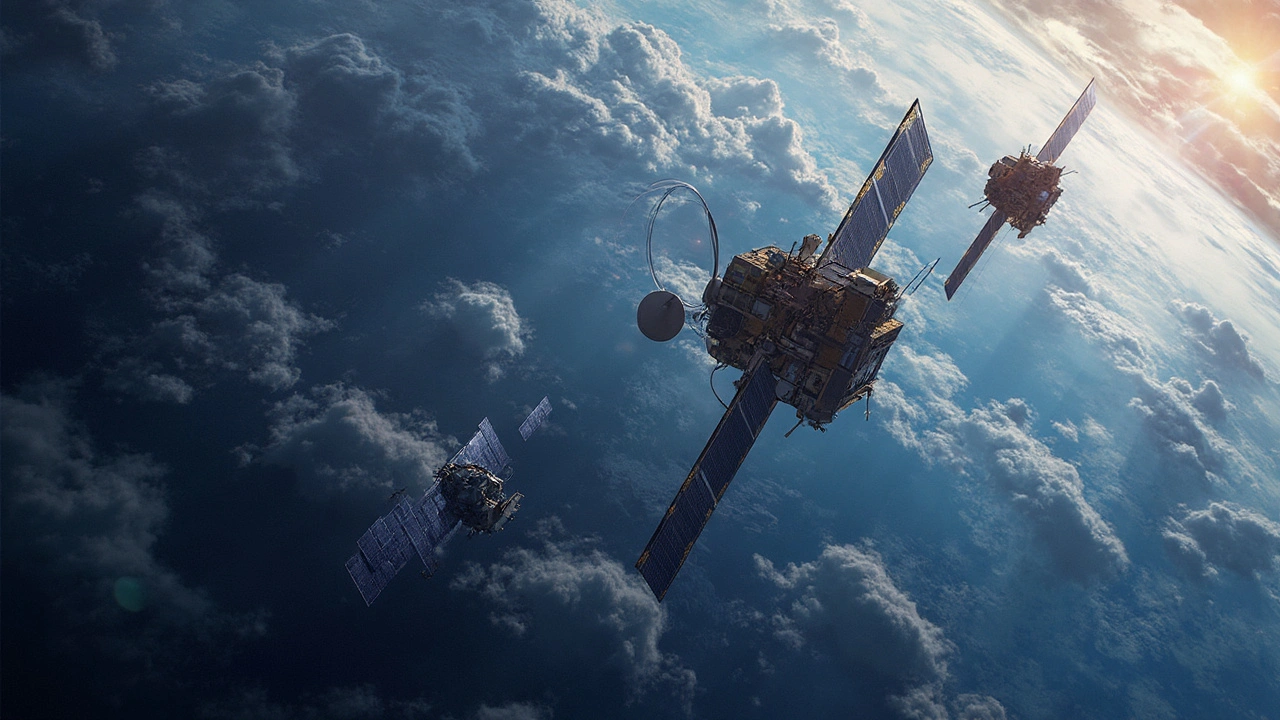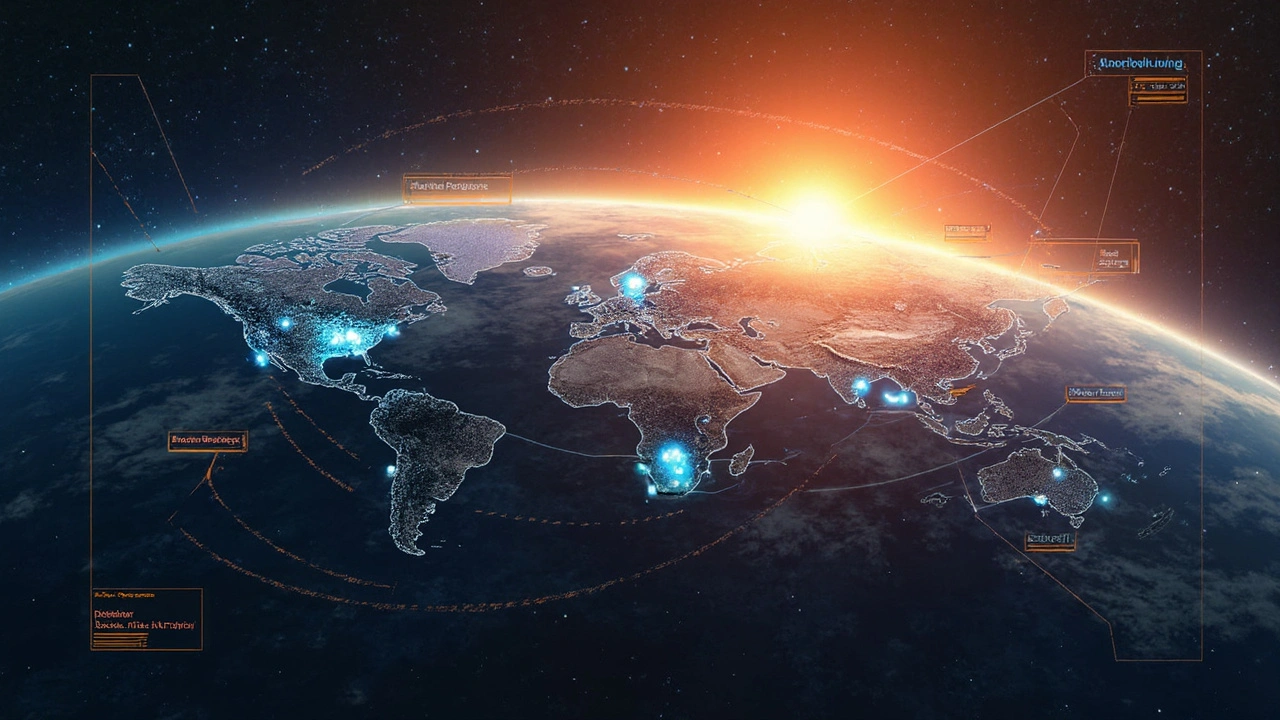We often hear about satellites, but what exactly are they doing up there? Buckle up because it’s more exciting than you might think! Satellites are like the unsung heroes orbiting our planet, performing a wide range of tasks that affect daily life. From helping you find your way with GPS to broadcasting your favorite TV shows, these gadgets are truly multifaceted.
Let's jump into the seven satellite states that keep our modern world connected and informed. Each of these satellites has a unique job, contributing to everything from weather predictions to environmental monitoring. Think of them as specialized team members, each playing a role in the vast operation that orbits Earth.
The types include communication satellites, weather satellites, Earth observation satellites, navigation satellites, reconnaissance satellites, space telescopes, and biosatellites. Sounds impressive, right? We'll take a closer look at what each one does and why they matter so much.
- Understanding Satellite States
- Types of Orbital Satellites
- Roles and Functions of Satellites
- Impact on Daily Life
- Future of Satellite Technology
Understanding Satellite States
Have you ever wondered what it means when people talk about satellite states? No, we're not talking about countries under the influence of another, but actual satellites orbiting Earth, fulfilling crucial roles. The term "satellite states" in this context refers to various types of orbital satellites circling our planet.
These aren't just metal boxes floating around aimlessly. Each satellite has a specific mission tailored to its design and orbit. They are divided into different categories based on what they're meant to accomplish.
Geostationary vs. Polar Orbits
First, let's talk about orbits. Some satellites are in a geostationary orbit, which means they move in sync with Earth's rotation. Imagine they're glued above a fixed point. This makes them perfect for purposes like communication because they’re always positioned over the same part of Earth.
On the other hand, polar orbits have satellites moving from pole to pole. They cover the entire Earth as the planet turns underneath. Satellites in polar orbit are essential for weather forecasting and Earth observation. Think of them as meticulous cartographers, constantly surveying new areas.
Essential Functions
Each of the seven satellite states serves specific functions, widely impacting various industries and everyday life:
- Communication Satellites – These are the ones helping you chat with Aunt Sally across the ocean.
- Weather Satellites – Yes, they're to thank for those 'chance of rain' forecasts.
- Earth Observation Satellites – They watch over forests, oceans, and urban areas for environmental change.
- Navigation Satellites – Ever used GPS? These are your guiding stars!
- Reconnaissance Satellites – Often used for security and defense, they keep a watchful eye in the sky.
- Space Telescopes – Like the Hubble, these gaze far beyond our planet to unlock cosmic mysteries.
- Biosatellites – They conduct biological experiments in space, contributing to science in extraordinary ways.
Understanding these satellite states gives us insight into how much they influence our lives. And as technology advances, their role is only set to grow, promising even greater contributions to our world.
Types of Orbital Satellites
Ever wondered what makes up the army of satellites hovering above us? These orbital satellites come in various shapes and sizes, each with its own mission. Let's break it down and see what each one does up there.
1. Communication Satellites
These are the ones making sure you never miss an episode of your favorite series. They handle everything from TV broadcasts to global phone calls. Satellite technology is crucial for beaming signals across the planet, avoiding pesky obstacles like mountains or oceans.
2. Weather Satellites
Sick of the rain ruining your plans? Weather satellites are the troubleshooters of the sky, predicting storms before they hit. They provide data that help meteorologists forecast the weather accurately so you know when to pack an umbrella.
3. Earth Observation Satellites
These explorers capture images of our planet, helping track changes in land, deforestation, and even urban sprawl. They're like the eyes of Earth, giving us a better understanding of how our world is transforming.
“Earth observation satellites offer unprecedented insights into environmental changes, crucial in today's climate-focused world.” – Anonymous Expert, 2023
4. Navigation Satellites
Ever rely on GPS to get you to that new coffee shop? Navigation satellites make this possible. By sending signals to your device, they help pinpoint your location with stunning accuracy. The GPS system is a game-changer in how we travel, both locally and globally.
5. Reconnaissance Satellites
Think spy satellites! These are the ones used for national security and intelligence. They monitor specific regions and can capture detailed imagery—think of it as looking at Earth through a magnifying glass.
6. Space Telescopes
If stargazing is your jam, you'll appreciate space telescopes. They look beyond our planet to observe distant stars and galaxies. It's like having a direct line to the universe's mysteries.
7. Biosatellites
Last but not least, biosatellites study living organisms in space. They help researchers understand how space travel affects biology, including human health, leading to advances in medical research.
These orbital satellites don't just float around aimlessly. They're hard at work supporting the fast-paced world we live in. Each type plays its part in keeping us connected, informed, and entertained.

Roles and Functions of Satellites
Satellites are crucial in our tech-driven world, performing roles that make everyday tasks easier and more efficient. Let's break down what these space wonders do.
Communication Satellites
These are the backbone of modern communication, enabling everything from live TV to high-speed internet. They beam signals across the globe, connecting corners of the earth that would otherwise be out of reach. Ever wondered how you can make a video call from a remote beach? Thank communication satellites.
Weather Satellites
Crucial for weather forecasting, these satellites track cloud movements and help predict storms. They provide images and data about weather patterns, helping meteorologists warn us about severe weather and saving countless lives each year. Imagine planning your day without a weather app!
Earth Observation Satellites
These are the earth's watchdogs, monitoring environmental changes, deforestation, and natural disasters. By capturing images of the planet, they help in understanding climate change and land use, assisting scientists and policymakers in making informed decisions.
Navigation Satellites
The mysterious heroes behind the GPS on your phone. These satellites track your location by transmitting signals to various receivers on Earth, guiding you to your destination, whether you're driving, hiking, or just strolling around a new city. Lost without them, aren’t we?
Reconnaissance Satellites
These are akin to space spies, used mainly for national security and defense purposes. They collect images and information about global military activities, remaining a vital part of maintaining global safety. Though rarely in the limelight, their role is crucial.
The Support System
Interestingly, satellites work in synergy, creating a network that supports multiple functions simultaneously. Next time you use a GPS or check the weather, remember the satellites tirelessly orbiting above.
Impact on Daily Life
It's wild to think how much orbital satellites affect our daily routines. Everything from checking the weather to binge-watching your favorite series involves these incredible technologies. They’re the reason you can get accurate GPS directions anywhere, even to that new coffee shop your friend told you about.
Staying Connected
Communication satellites make sure we're never out of touch. Whether you're video chatting with a friend overseas or streaming music on a road trip, satellites have our backs. The signals that bounce around in space are what allow for global communication systems, like the internet, to function smoothly.
Keeping You Safe and Informed
Want to know if you need an umbrella? Weather satellites provide precise forecasts that help you plan your day, but they also issue warnings for severe weather events, like hurricanes, giving you time to prepare and stay safe.
Navigating the World
Navigation satellites are crucial for GPS services. Remember the last time you used your phone to find a new place? That was GPS in action, which relies on this amazing network of satellites to pinpoint your location down to a few meters.
Entertaining and Educating
Ever wonder how your favorite TV shows and sports get beamed into your living room? Broadcast satellites send these signals directly to your TV, providing us with endless entertainment options and educational content at our fingertips.
Important Industrial Applications
Industries like agriculture and logistics lean heavily on satellite data. Earth observation satellites track environmental changes and help farmers improve crop yields, while supply chains rely on satellites to monitor routes and manage inventories effectively.
More Than a Gadget
It’s easy to overlook, but satellites are more than just gadgets orbiting above – they play vital roles in connecting and protecting the world we live in. Next time you send a text, watch the weather report, or find your way around town, you know who to thank!

Future of Satellite Technology
The future of satellite technology is set to change the way we interact with our world. Think about how much life has changed with the smartphones in our pockets. Now imagine that same kind of evolution happening in space!
The next decade promises slimmer, more efficient satellites that are cheaper to launch. That's because the trend is moving towards small cubesats, which are like the tiny, tidy boxes of space technology. They can be launched in groups and perform many of the same tasks as a single, larger orbital satellite but with much less weight.
Networked Swarms
This leads us to the concept of 'swarm satellites.' Instead of one large satellite, imagine a crowd of tiny ones exchanging data and coordinating tasks. It’s like having an army of flying helpers constantly solving problems, from monitoring climate changes to snapping high-res images of our planet.
Satellite Internet for Everyone
Companies like SpaceX and Amazon are racing to build constellations of satellites that might bring high-speed internet to every corner of the globe. Imagine everyone, everywhere, accessing the same information online without worrying about cables or ground-based infrastructure.
The numbers are staggering. By 2028, we might see around 50,000 of these networked satellites orbiting Earth, bouncing data back and forth.
Advanced Space Exploration
But it's not all about what happens here on Earth. Satellites are becoming essential for space exploration, too, acting as our eyes and ears far beyond our planet. With continually improving technology, they're set to scout asteroids and planets, sending data back with unprecedented clarity and speed.
| Year | Estimated Satellite Launches |
|---|---|
| 2025 | 1,500+ |
| 2030 | 5,000+ |
So, the next time you look up at the sky, know that those twinkling spots might not just be stars. They could be part of an ever-increasing network of satellites making our digital experiences faster and our planet more connected. Now that’s a future worth looking forward to!

